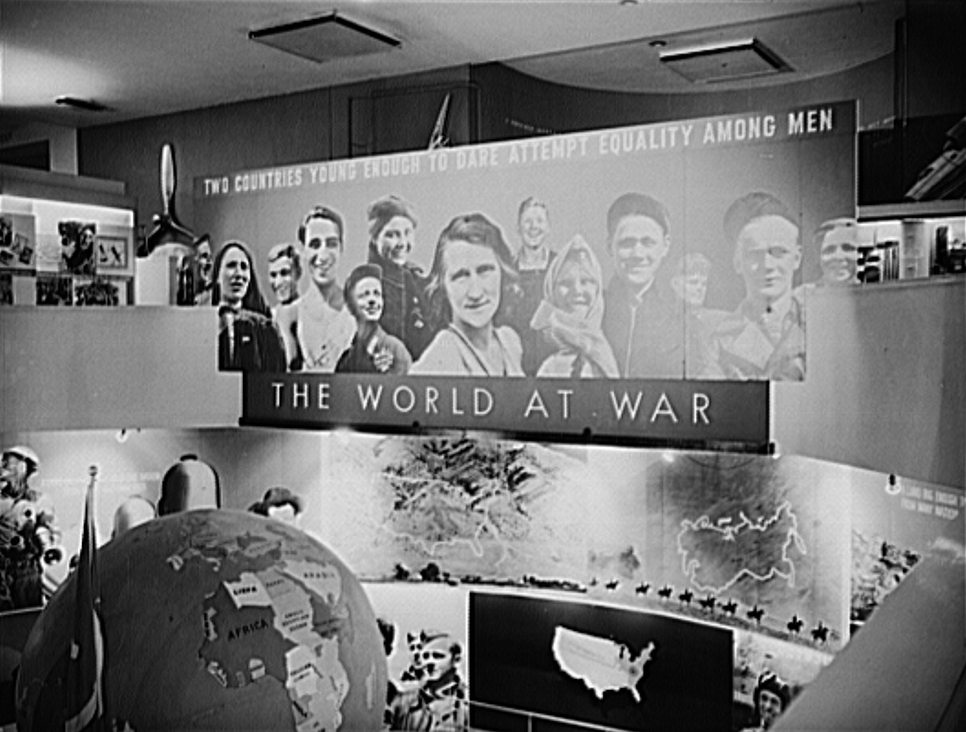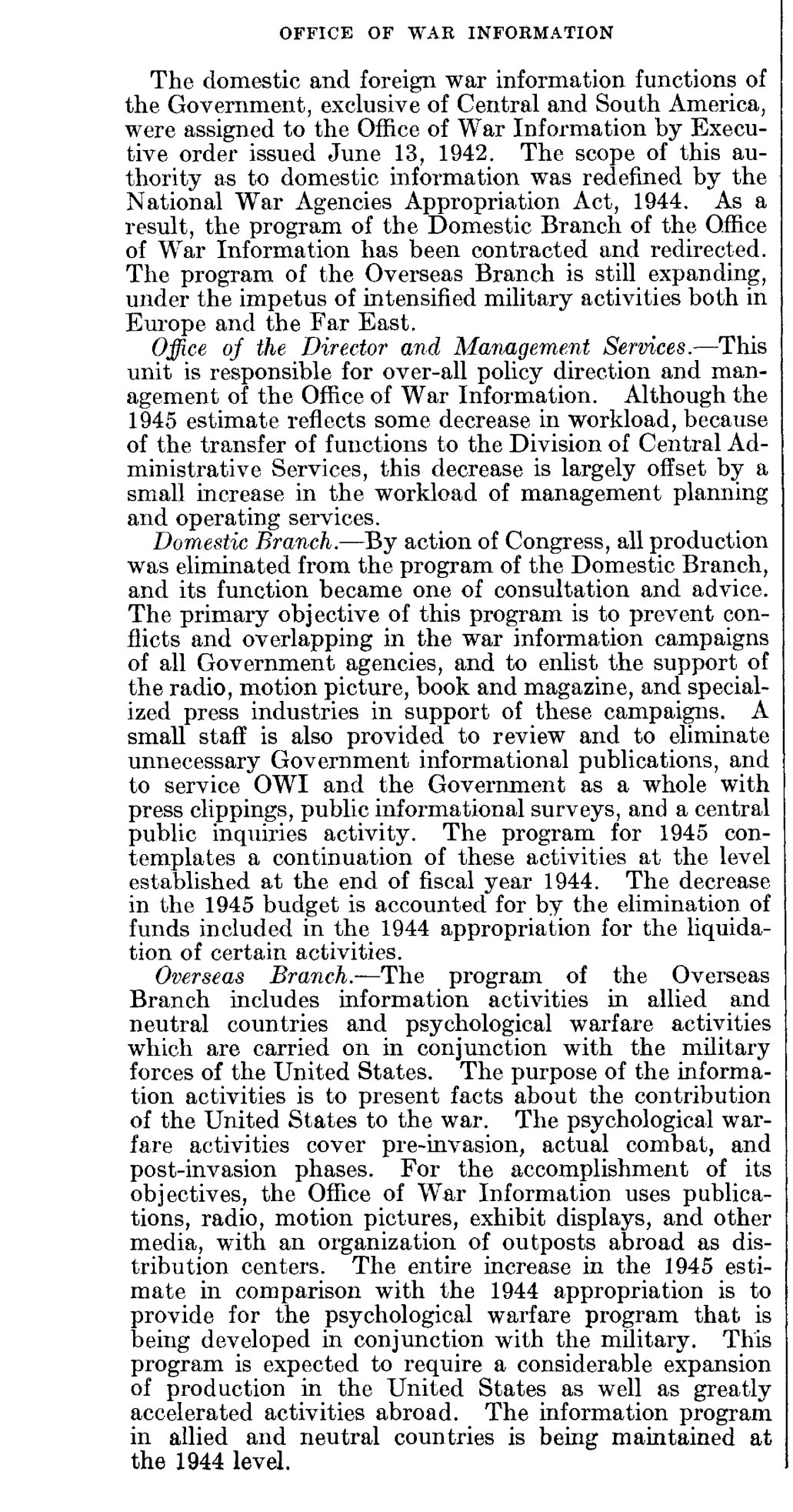Introduction
With today’s 75th anniversary of the signing of the presidential executive order to imprison Japanese Americans during World War II, when it comes to understanding who really initiates and creates government propaganda in the United States sometimes a little knowledge of history is needed to see through today’s problems and challenges.
With Voice of America (VOA) journalists (federal employees and contractors) resorting to practicing their own personal “journalistic” activism in support of their own worldview and partisan causes and political candidates (See: “Voice of America compares Trump to Lenin, Stalin, Mao in a one-sided attack“), it is worth to remember that this is nothing new in the history of the taxpayer-funded U.S. government agency.
During World War II, VOA also operated without much oversight and also engaged in vigorously spreading its own internally-driven propaganda. Such propaganda was superficially in line with what the White House and the State Department wanted at the time, but loosely supervised VOA officials and broadcasters sometimes worked against U.S. government’s and America’s interests in support of their own agenda and ideological causes, and in some cases on behalf of other countries.
Contrary to popular belief, the greatest propagandists working for the U.S. government during World War II were not the President of the United States, the Secretary of State, or White House or State Department officials. They were primarily Voice of America activist journalists and their activist bosses. Even the wartime U.S. State Department was opposed to some of the lies VOA officials and broadcasters told in support of Stalin and the Soviet Union. Much of the propaganda and most of the propaganda lies about the Soviet Union were initiated not by the White House, the State Department, the Pentagon or the Office of Strategic Services (OSS), but by the Office of War Information and the Voice of America “journalists” and top leaders.
World War II era Voice of America very much resembled the dysfunctional Broadcasting Board of Governors (BBG), VOA’s current parent agency. But even then, unlike today, while VOA broadcasters and officials generally put on the air whatever they wanted, which is what they do today with even greater freedom, they were smart enough not to engage in blatant U.S. domestic propaganda on behalf of domestic U.S. political causes and political candidates. Even then, however, they were rightly suspected in the U.S. Congress and by much of the U.S. private commercial media of having a strong political bias.
Within the last year and an half, the Voice of America programming has become more blatantly partisan than it has been at any time in VOA’s history. The Voice of America Charter, a 1976 U.S. law, has been almost completely ignored. During World War II, as well as today, some VOA journalists spoke up against internal propaganda generated by some of their bosses and colleagues, but they soon met with reprisals and were quickly silenced. A Jewish refugee from Austria, Julius Epstein, an outstanding OWI journalist who actively opposed pro-communist propaganda in World War II VOA broadcasts has been forgotten by history while VOA’s premier pro-Soviet propagandist John Houseman is still sometimes presented as a defender of truth, independent journalism and free expression. Such are the ironies of history.
BBG Watch History
On February 19, 1942, President Franklin D. Roosevelt authorized the internment Japanese Americans with Executive Order 9066. His order allowed local military commanders to designate “military areas” as “exclusion zones,” from which “any or all persons may be excluded.” The forced relocation and incarceration in camps in the interior of the country affected between 110,000 and 120,000 people of Japanese ancestry who lived on the Pacific coast. Sixty-two percent of the internees were United States citizens.
President Roosevelt’s order touches on the early history of the Voice of America which has been well hidden and almost completely forgotten for decades. The Voice of America was initially part of the Office of War Information (OWI), which produced propaganda films in support of the imprisonment of American citizens without any due process, while VOA itself was also defending these actions and creating pro-Soviet and pro-Stalin propaganda. This was a far cry from VOA broadcasting all news, good or bad, from the very beginning, as was later claimed. The OWI also engaged in illegal censorship of U.S. domestic media, mainly ethnic radio stations and newspapers which were critical of the Soviet Union and exposed Stalin as a mass murderer.
Some of Voice of America’s WWII broadcasters who produced pro-Soviet VOA propaganda later worked as anti-U.S. propagandists for Soviet-dominated communists regimes in Eastern Europe. Former VOA “journalists,” one of whom was Stefan Arski (who also used the name Artur Salman), repeated the same lies for East European communist media which they had told earlier in VOA programs in their attempts to cover up Stalin’s crimes. Some of the same lies were also repeated by their OWI and VOA bosses.
The “Founding Father” of the Voice of America, playwright and FDR’s speechwriter Robert E. Sherwood, was in charge of coordinating U.S. and Soviet propaganda at the Voice of America and throughout the Office of War Information.
The Voice of America did not drop its pro-Soviet line and was not reformed to resemble more of a news and war of ideas operation until well after World War II. Even then, it took strong bipartisan pressure from Congress to force these reforms upon the government bureaucracy. Thanks to a new staff of journalists who were refugees from communist-controlled Eastern Europe and knew Soviet communism first hand, VOA eventually became a voice of free speech in defense of freedom and democracy, but it took several years to achieve it.
SEE: 75th Anniversary of Voice of America – Propaganda Coordination with USSR
SEE: Internment of Japanese Americans
SEE: Propaganda for Japanese-American internment
Contrary to later claims, VOA was not established by the U.S. government within the U.S. government as a news organization. It was established in 1942 as the the “Overseas Branch” of the Office of War Information (OWI), which according to a description in the “U.S. Federal Budget for Fiscal Year 1945 — War Supplement,” saw VOA as conducting “information activities in allied and neutral countries and psychological warfare activities which are carried on in conjunction with the military forces of the United States.“
The first Voice of America director, Hollywood actor John Houseman, was along with many of his colleagues in management and broadcasting positions a fierce defender of the Soviet Union and “Soviet socialism.” He was forced to resign in 1943 when VOA’s pro-Moscow propaganda became too much even for the Roosevelt White House. Pro-communist VOA commentators were trying to sabotage U.S. government’s attempts to get Italy’s pro-German government out of the war because Stalin objected to any deals with Hitler’s allies.
Many assume that the White House and the U.S. government’s executive branch in general were behind most of OWI’s and VOA’s pro-Soviet and other propaganda. That is to some degree correct, but in reality the most active and eager propagandists in support of the Soviet Union and Stalin, who sometimes worked against U.S. military and foreign policy directives, were poorly-supervised OWI and VOA officials, journalists and other employees. Both OWI director Elmer Davis and first VOA director John Houseman repeatedly referred to Voice of America programs as designed for wartime propaganda and wartime psychological operations. Even after the war, they lashed out against critics who exposed their pro-Stalin propaganda. They used slurs to discredit noncommunist East European diplomats and others who had warned them that their pro-Soviet propaganda will damage the Voice of America and the United States.
This is what scholar of U.S. World War II propaganda Holly Cowan Shulman, who is the daughter of one of the early VOA directors and the sister of a later VOA director, wrote about early Voice of America propagandists. Her book, “The Voice of America: Propaganda and Democracy, 1941-1945,” was published in 1990 by The University of Wisconsin Press:
“Sherwood, Barnes, Wartburg, and Johnson, and their like-minds colleagues the Overseas Branch [OWI’s Voice of America] believed that propaganda could mold and influence foreign policy. Propaganda, in other words, was not merely an expression of policy made by others. The propagandists believed they could make their own version of American foreign policy come true. They believed they were right; they argued that they understood the foreign influence of American policy ways that the State Department, and even the president, did not; and they used the Voice of America to enter the foreign policy debate between members of the Roosevelt’s administration.” [ref]Holly Cowan Shulman, The Voice of America; propaganda and Democracy, 1941-1945 (Madison: The University of Wisconsin Press, 1990, p. 91.[/ref]
Office of War Information
Office of War Information, O.W.I., was created in June 1942 during World War II as a propaganda and psychological warfare agency of the Executive Branch, targeting both domestic and foreign audiences. Its director, Elmer Holmes Davis, reported directly to President Franklin Delano Roosevelt. O.W.I. Overseas Branch included the Voice of America, VOA, radio broadcasts, which were strongly pro-Soviet throughout the war, with any negative news about the Soviet Union censored out. These O.W.I. radio broadcasts were not commonly referred to during the war as Voice of America or VOA programs, but the Voice of America name was eventually adopted.
The O.W.I. was viewed with great suspicion by Congress and often criticized for attempts to censor U.S. media, pro-Soviet propaganda at home and abroad, mismanagement, and questionable quality of its programs. It also had a few supporters, mainly among the most pro-Soviet members of Congress. Because of numerous controversies, President Truman abolished the O.W.I. by executive order on August 31, 1945 and placed VOA within the State Department.
The Smith-Mundt Act of 1948 tried to address some of the abuses of the wartime O.W.I. and VOA management. The legislation put restrictions on propaganda by the Executive Branch in the United States and tried to prevent hiring of foreign agents as VOA broadcasters by requiring strict security clearances for VOA personnel.
The move to the State Department and the departure of the pro-Soviet O.W.I. staff shortly after the end of WWII helped to establish some journalistic credibility for VOA during the Cold War. In 1953, VOA was again moved, this time to the newly established United States Information Agency (USIA). In the late 1940s and early 1950s, VOA was viewed as less than fully effective in countering Soviet propaganda. This led to the establishment of Radio Free Europe and Radio Liberation (later renamed Radio Liberty) in the early 1950s under then covert management of the Central Intelligence Agency (CIA).

Smith, Roger, photographer. New York, New York. Murals at the American-Soviet war exhibition designed by the OWI Office of War Information and installed in the Museum of Science and Industry. June, 1943. Image. Retrieved from the Library of Congress, https://www.loc.gov/item/owi2001030188/PP/. (Accessed September 02, 2016.)
The O.W.I. slogan about the Soviet Union and the United States in June, 1943 reads: “TWO COUNTRIES YOUNG ENOUGH TO DARE ATTEMPT EQUALITY AMONG MEN.”
From the BUDGET FOR FISCAL YEAR 1945 – WAR SUPPLEMENT

OFFICE OF WAR INFORMATION
The domestic and foreign war information functions of the Government, exclusive of Central and South America, were assigned to the Office of War Information by Executive order issued June 13, 1942. The scope of this authority as to domestic information was redefined by the National War Agencies Appropriation Act, 1944. As a result, the program of the Domestic Branch of the Office of War Information has been contracted and redirected. The program of the Overseas Branch is still expanding, under the impetus of intensified military activities both in Europe and the Far East.
Office of the Director and Management Services.—This unit is responsible for over-all policy direction and management of the Office of War Information. Although the 1945 estimate reflects some decrease in workload, because of the transfer of functions to the Division of Central Administrative Services, this decrease is largely offset by a small increase in the workload of management planning and operating services.
Domestic Branch.— By action of Congress, all production was eliminated from the program of the Domestic Branch, and its function became one of consultation and advice. The primary objective of this program is to prevent conflicts and overlapping in the war information campaigns of all Government agencies, and to enlist the support of the radio, motion picture, book and magazine, and specialized press industries in support of these campaigns. A small staff is also provided to review and to eliminate unnecessary Government informational publications, and to service OWI and the Government as a whole with press clippings, public informational surveys, and a central public inquiries activity. The program for 1945 contemplates a continuation of these activities at the level established at the end of fiscal year 1944. The decrease in the 1945 budget is accounted for by the elimination of funds included in the 1944 appropriation for the liquidation of certain activities.
Overseas Branch.[Voice of America]— The program of the Overseas Branch includes information activities in allied and neutral countries and psychological warfare activities which are carried on in conjunction with the military forces of the United States. The purpose of the information activities is to present facts about the contribution of the United States to the war. The psychological war fare activities cover pre-invasion, actual combat, and post-invasion phases. For the accomplishment of its objectives, the Office of War Information uses publications, radio, motion pictures, exhibit displays, and other media, with an organization of outposts abroad as dis tribution centers. The entire increase in the 1945 estimate in comparison with the 1944 appropriation is to provide for the psychological warfare program that is being developed in conjunction with the military. This program is expected to require a considerable expansion of production in the United States as well as greatly accelerated activities abroad. The information program in allied and neutral countries is being maintained at the 1944 level.

